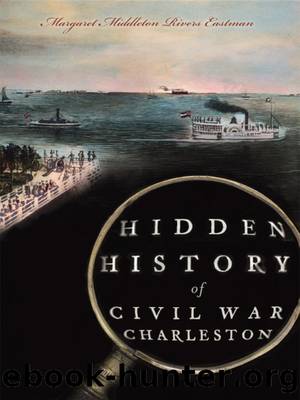Hidden History of Civil War Charleston by Margaret Middleton Rivers Eastman

Author:Margaret Middleton Rivers Eastman
Language: eng
Format: epub
Publisher: Arcadia Publishing Inc.
Published: 2012-09-14T16:00:00+00:00
CHAPTER 12
The Union Strikes Back
1863–1864
THE IRONCLAD ATTACK
In September 1862, President Lincoln announced that he would emancipate all slaves in the Confederate states that did not return to the Union by January 1, 1863. As none complied, Lincoln used his war powers to issue a formal emancipation proclamation on January 1, 1863. The Proclamation made abolition a justification of the war, but it did not immediately affect Charleston.
After its humiliating defeat at Fredericksburg in December, the war-weary North was clamoring for a decisive victory. Assistant secretary of the navy, Gustavus Fox, in particular, was obsessed with capturing Charleston after his failure to relieve Fort Sumter two years earlier. He came up with the idea of destroying the shipping channels covered in the chapter entitled “Sinking of the Great Stone Fleet.”
The Union navy had already assigned almost all of its armored vessels to the South Atlantic Blockading Squadron, and throughout the winter of 1862–63, Admiral Samuel F. DuPont prepared for an attack in Port Royal. The armada arrived off the coast of Charleston on April 7, almost exactly two years after the fall of Fort Sumter. The assault force consisted of seven single-turreted ironclad monitors and the 3,500-ton New Ironsides armed with sixteen Dahlgren guns and two Parrott rifles. Thirty wooden boats accompanied the ironclad fleet.
To support the maritime action, General David Hunter had come up the coast and landed troops on Seabrook Island and Johns Island with the intent of conquering James Island. In response to the enemy buildup, the Confederate command deployed every available man to James Island and the harbor’s entrance.
Charleston harbor was defended by sixty-three forts and batteries, as well as mines and submerged ropes designed to catch ships’ propellers. The perimeter fortifications were so numerous they were said to resemble a porcupine with its quills turned out.
The ironclad attack was led by the monitor Weehawken, pushing a raft designed to detonate torpedoes. Weehawken was followed by three monitors, the mighty New Ironsides and finally four more monitors. (Percival Drayton was in command of the monitor Passaic, and Robert Smalls, the escaped river pilot, captained the experimental double-turreted Keokuk.)
A man of the old wooden navy, Admiral DuPont had little confidence in the new iron warships, and his worst fears were realized. The cumbersome ironclads were unable to navigate properly in the strong channel currents. Slowed down, they were caught in a heavy crossfire from Confederate defenses. The battle raged for over two hours. The Confederates fired 2,200 shots, and the Union ships retaliated with all they had to offer. All the while, curious spectators crowded onto the battery to witness the engagement.
The armored fleet was severely battered and withdrew at nightfall. DuPont fully intended to continue the assault the following day, but the attack never materialized. Five ironclads had been disabled, and the Keokuk had sustained ninety direct hits before it sank during the night.
DuPont’s subordinates later persuaded him to withdraw, and towing the badly damaged vessels, the remaining ships slowly made their way back down the main channel.
Download
This site does not store any files on its server. We only index and link to content provided by other sites. Please contact the content providers to delete copyright contents if any and email us, we'll remove relevant links or contents immediately.
| Africa | Americas |
| Arctic & Antarctica | Asia |
| Australia & Oceania | Europe |
| Middle East | Russia |
| United States | World |
| Ancient Civilizations | Military |
| Historical Study & Educational Resources |
The Dawn of Everything by David Graeber & David Wengrow(1654)
The Bomber Mafia by Malcolm Gladwell(1589)
Facing the Mountain by Daniel James Brown(1504)
Submerged Prehistory by Benjamin Jonathan; & Clive Bonsall & Catriona Pickard & Anders Fischer(1420)
Wandering in Strange Lands by Morgan Jerkins(1375)
Tip Top by Bill James(1352)
Driving While Brown: Sheriff Joe Arpaio Versus the Latino Resistance by Terry Greene Sterling & Jude Joffe-Block(1340)
Evil Geniuses: The Unmaking of America: A Recent History by Kurt Andersen(1321)
Red Roulette : An Insider's Story of Wealth, Power, Corruption, and Vengeance in Today's China (9781982156176) by Shum Desmond(1316)
The Way of Fire and Ice: The Living Tradition of Norse Paganism by Ryan Smith(1305)
American Kompromat by Craig Unger(1271)
It Was All a Lie by Stuart Stevens;(1265)
F*cking History by The Captain(1254)
American Dreams by Unknown(1238)
Evil Geniuses by Kurt Andersen(1226)
Treasure Islands: Tax Havens and the Men who Stole the World by Nicholas Shaxson(1222)
White House Inc. by Dan Alexander(1181)
The First Conspiracy by Brad Meltzer & Josh Mensch(1141)
The Fifteen Biggest Lies about the Economy: And Everything Else the Right Doesn't Want You to Know about Taxes, Jobs, and Corporate America by Joshua Holland(1092)
